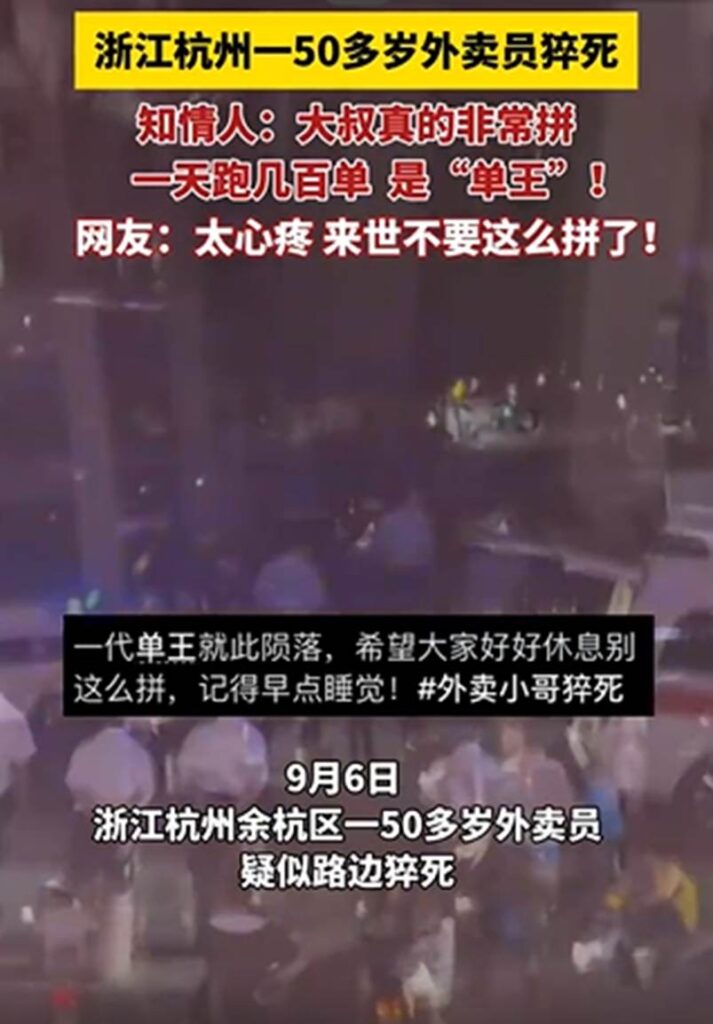It’s never a good night when the texts start rolling in from my government colleagues. Last night was the worst one yet. Reductions in force (RIF) notices began pouring into inboxes across the US federal government, disproportionately at the CDC. Entire centers had their leadership teams gutted, along with all their staff. This is the comprehensive dismantling of America’s national public health agency. One of my friends texted me last night: “They are eviscerating us. It’s surreal.”
These RIFs spanned the US government and were the work of Office of Management and Budget Director Russell Vought. President Donald Trump and the Republicans forced a government shutdown as a further means of centralizing power within the Executive Branch and cementing Trump’s authoritarian rule. Trump is shamelessly spreading propaganda like this “Government Shutdown Clock” on .gov websites blaming the Democrats for the shutdown he and his party engineered. The Democrats aren’t capitulating yet, but they aren’t really doing much else of note. So Vought is using the ongoing government shutdown as a pretext to continue his premeditated murder spree of the federal workforce.
More than 4,000 public servants lost their jobs across the government last night. More than 1100 people of those were from the Department of Health and Human Services (HHS), and from what my colleagues in multiple HHS agencies tell me, that was overwhelmingly concentrated at CDC.
To be very clear, these RIFs are illegal. There is nothing in the US Constitution that gives the President the power to begin culling civil servants because the government is shut down. The entire point of the division of power in American democracy is that the President doesn’t have unlimited power over the whole of government, nor is he authorized to just fire entire organizational units of federal employees for political reasons. Trump and Vought are, as usual, trying to see what they can get away with.
However, if they get away with these lawless RIFs at CDC, the consequences will include a death toll. The people who got RIF notices work on some of our most critical public health functions. Without them, CDC will not be able to provide these services. And without these services, Americans—and people around the world—will die.
CDC had already been brutalized by the Trump administration. Besides suffering massive cuts on the Valentine’s Day and April Fool’s Massacres, Trump and HHS Secretary Robert F. Kennedy, Jr. have defunded critical programs, scaled back essential surveillance, dissolved expert committees, overridden standard evidence-based practices, descheduled critical childhood vaccines, ignored the domestic terror attack in August, purged CDC of its leadership, and installed incompetent, unqualified, ideologically monstrous political appointees like Acting CDC Director Jim O’Neill. This severely impaired CDC’s normal function. One colleague described their current job as finding “bureaucratic cheat codes” to carry out their most basic duties, which is all they can accomplish because CDC was already so thoroughly shucked of staff and experience. Yesterday’s purge will likely deal a death blow to most critical functions of an agency that was already on life support.
This will also deal a literal death blow to many, many people outside the agency, given what the CDC employees who were let go actually did at work. The CDC was not just the world’s model for national public health agencies because it marketed itself well; it’s because the CDC actually did things to benefit public health and developed a lot of expertise in doing those things. Now there is nobody there to carry out that work. It’s worth exploring what CDC will no longer be able to do.
The National Center for Immunization and Respiratory Disease (NCIRD) is the part of CDC that runs national vaccination programs and responds to respiratory diseases. The entire Office of the Director (OD), including the Acting Director, and all centers within the OD received RIF notices. The Office of Data Surveillance and Informatics in the Immunization Services Division was eliminated, so there goes our ability to track and access data on vaccination and vaccine-preventable diseases. So did employees in NCIRD’s policy office, so bid farewell to the ability of make evidence-based public health policy recommendations for pandemics and immunization. And don’t expect any medical guidance either, since the Chief Medical Officer’s office was eliminated. This may not be surprising, given the reasons why former Chief Medical Officer Debra Houry resigned on principle at the end of August.
Epidemic and pandemic preparedness and response is now crippled. The Public Health Infrastructure Center (PHIC) lost its OD too, as well as its Division of Partnership Support, which supports coordination between CDC and state and local officials in outbreak response. RIFs at the Division of Workforce Development included the entire 2023 and 2024 classes of civilian Epidemic Intelligence Service (EIS) officers. EIS officers are the epidemiologists who respond to outbreaks and contain them. But civilians weren’t the only ones impacted—RIF notices also went to the Commissioned Corps Liaison Office that coordinates Public Health Service officers on duty at CDC. The Global Health Center (GHC), which extends CDC’s capabilities globally to build response capacity, also lost its entire OD. At the National Center for Emerging, Zoonotic, and Infectious Diseases (NCEZID), both the Enteric Diseases Laboratory Branch and the Poxvirus and Rabies Branch were RIFed. The CDC now has no capacity whatsoever to respond to emerging infectious threats, including outbreaks of respiratory diseases like COVID and flu, foodborne illnesses, and less common but still severe outbreaks of mpox and rabies. There is no infrastructure to support responders, experts to investigate and contain outbreaks, or ability to coordinate with state and local health officials on the ground, at home or abroad. CDC experts actively responding to an Ebola outbreak in the Democratic Republic of Congo that has killed 43 people were RIFed in the middle of their deployment.
It is not just outbreak response being decimated. The entire OD working on Chronic Diseases was eliminated, despite chronic illness being a stated priority of Kennedy’s MAHA agenda. The National Health and Nutrition Examination Survey staff at the Office of Public Health Data, Surveillance, and Technology received RIF notices, as did people in policy and communications at the National Center for Injury Prevention and Control (NCIPC)’s Office of Program Management and Operations. Employees working on Behavioral Intelligence, devoted to helping understand how behavior affects chronic disease, injury, nutrition, and illness through rigorous data collection, also were given notice.
CDC will no longer be able to inform the public about health threats facing the nation, either. Center for Forecasting and Analytics (CFA) staff dedicated to the Inform pillar of their mandate is gone. CFA tracks, models, and predicts epidemic trajectory and severity, so they no longer can share their critical findings with the public. Over in the Office of Science, the entire staff of the Morbidity and Mortality Weekly Report (MMWR) has been fired, as have many in the Office of Science Dissemination that oversees MMWR. This prevents CDC from sharing critical information about health with the public in a deeply trusted, reliable report that has been published weekly for more than 60 years. The CDC Library and CDC Museum also were RIFed, denying federal employees and the public from accessing essential, taxpayer supported historical, scientific, and educational resources. The CDC will no longer be able to inform national policy, either, as the entire Washington, DC office, charged with coordinating CDC activity with DC policymakers has been terminated.
Beyond that, the CDC will not be able to function administratively, as the Office of Safety, Security, and Asset Management (OSSAM) office, which safeguards employee, facility, and data security at CDC lost its entire Occupational Health and Safety Office. Barely two months after a gunman shot more than 500 rounds at CDC and killed a police officer, the office devoted to employee safety has been unceremoniously booted. The Workplace Health Office was also RIFed, as was the Office of Strategic Business Initiatives, which is charged with training and supporting risk management across the entire agency. Not only have the CDC employees been terminated, but the ones who remain will be forced to function within an organization that has eliminated mechanisms for looking after their well-being, safety, and ability to effectively do their jobs to carry out the CDC mission.
These RIFs, if allowed to remain, will prevent CDC from functioning at all. That has profound consequences for everyone’s health, in America and overseas.
This is a terrible time for America to lose its public health capacity. Declining vaccination rates put us at risk of even larger and larger preventable disease outbreaks. America will lose measles elimination status. More diseases will be imported. Outbreaks will go unrecognized and unchecked. These epidemics will strain health care systems, probably in some cases to the point of breaking them. Because there is no surveillance capacity, we will not be able to track these epidemics accurately or collect data on them. Apart from epidemics, our national health systems will be further strained as the impacts of untracked, untreated chronic diseases make more Americans sicker and sicker.
But there is another monster looming just out of frame. Currently, highly pathogenic H5N1 avian flu is causing massive bird outbreaks nationwide, with 41 confirmed infected flocks comprising more than 6.3 million birds. The majority of these outbreaks are occurring in commercial poultry operations. This is a minefield and it’s just a matter of time before someone takes one wrong step and the entire thing blows up.
Right now, H5N1 is not capable of transmitting from human to human. However, with enough opportunity to infect humans and adapt to them, it could acquire that ability. As we enter flu season, the risk goes up considerably because H5N1 could reassort with a seasonal flu virus in a co-infected person. This would allow it to make a rapid evolutionary leap and acquire human-to-human transmissibility virtually overnight. To reduce that risk, we need to identify and prevent human infections. We need to monitor circulating viruses, especially in humans, to detect reassortants and track their spread. We need to have laboratory diagnostic testing and genomic sequencing, as well as accessible and transparent frameworks for gathering and sharing these critical data. We need to reduce seasonal flu circulation by increasing flu shot uptake as much as possible. We need to have EIS response teams ready to act if there is evidence of human-to-human transmission. CDC is no longer able to conduct surveillance and response. CDC no longer has the capacity to collect or analyze these data, or share it with state, local, or academic partners. CDC no longer has adequately staffed response teams or offices devoted to immunization campaigns. CDC has no leadership across multiple centers and offices that previously carried out this critical work. CDC cannot respond to this threat, which has the potential to kill hundreds of millions of people.
If H5N1 does make the jump in the US, we will likely not know about it until it is already a pandemic. Here is a nightmare scenario: H5N1 begins spreading. Based on cases so far, this virus makes about 6% of infected people sick enough for hospitalization. It has about a 2% mortality rate based on known cases.
If 6 patients show up at a clinic or a medical facility and they all have community-acquired H5N1, that means there are 94 other infected people who are not very sick but may be contagious. They feel well enough to travel, to socialize, to go to work, to play with their children, and to carry on with their daily lives. They will infect other people. The virus can spread around the world before we even know it’s spreading because the CDC can’t look for it. Those 6 patients will be the first of a pandemic that has already begun. It will be much, much worse than COVID.
A 2% mortality rate may seem small, but at population scale that translates to a minimum of 7 million dead Americans, with more than 150 million deaths globally. That is just from human infections. H5N1 also kills or infects a number of other agriculturally important species, like poultry, dairy cows, and swine. It has been increasingly killing ecologically important wildlife species and domestic and peridomestic mammals for months. Overwhelmed health care systems, food shortages, and economic, agricultural, and environmental devastation will kill far more people than the pandemic flu alone. This is an existential threat to human civilization as we know it.
I can’t say if H5N1 will become a pandemic or not. I don’t know and nobody else does either. However, I do know that America and the world needs CDC more than ever.
This is terribly dark and depressing, but there is hope. As I said before, these RIFs are completely illegal and unconstitutional. There is a reason why they were issued on a Friday night. Vought and the Trump administration know they are completely unjustified. They don’t want people to know what they did and what the consequences will be, because they know that they are unlawful. They know their position is weak.
Yes, fired employees need to sue and take this to the courts. However, there are still court cases percolating through the justice system regarding layoffs that happened months ago. CDC’s function is too urgent to wait. Congress must step in now and reverse this as they continue to negotiate an end to the shutdown. This is not solely the Democrats’ responsibility, either. People not dying preventable deaths is a bipartisan issue. As Americans, we must demand that our government not enact illegal policies that will kill us. Congress must act and restore functioning public health capacity to the nation now, before we all regret it. At least, before those of us who survive do.









